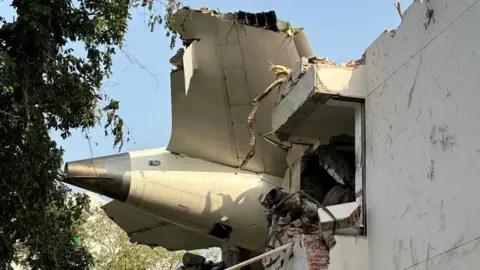A preliminary report regarding the recent Air India crash has surfaced, shedding light on critical factors leading up to the tragic incident. According to initial findings, it was noted that the fuel supply to the engines of the Boeing 787-8 Dreamliner was cut off just moments after the aircraft took off from Ahmedabad airport on June 12. This catastrophic failure led to the loss of 260 lives, with the vast majority being passengers onboard the ill-fated flight, which was destined for London Gatwick.
The investigation, spearheaded by India’s Aircraft Accident Investigation Bureau (AAIB), highlighted a crucial exchange captured in the cockpit voice recordings. One pilot was recorded asking, “why did you cut off?” while the other claimed he had not made such a decision. The audio exchange indicates a possible miscommunication or inadvertent action that could have proved fatal.
Data retrieved from the flight recorder revealed that both fuel control switches transitioned from the “run” to “cut-off” position within a second, shortly after the takeoff phase began. Such switches are primarily utilized for shutting down engines, which occurs typically after landing or in the event of an emergency—rendering their engagement during takeoff highly unusual. The report from the AAIB stated that this catastrophic switch action resulted in an immediate loss of thrust from both engines, creating confusion within the cockpit as the pilots attempted to ascertain why the fuel had been cut.
Captain Sumeet Sabharwal and co-pilot Clive Kundar were at the controls during this flight, and while the report does not specify which pilot was which in the recordings, it does indicate that a Mayday call was made just before the plane plummeted into a building designated for doctors’ accommodation. This crash caused a significant explosion, adding to the tragedy.
Furthermore, the report has dismissed speculation that the crash could have resulted from avian interference, as “no significant bird activity” was noted around the aircraft’s flight path. Both pilots had reportedly enjoyed an adequate rest period prior to the flight. The findings also drew attention to the fact that a similar design of fuel control switches is utilized on other Boeing 787 models, but the Federal Aviation Administration (FAA) had previously reported no action demanding inspections of these switches, as the situation was not deemed unsafe.
In a statement, an Air India spokesperson confirmed that the airline is cooperating fully with the AAIB as the investigation unfolds. They refrained from discussing specific details but assured the public of their commitment to transparency once possible. Boeing, the manufacturer of the aircraft, remarked that they would defer to AAIB’s findings while continuing their support for both the investigation and Air India.
The implications of this crash reach far beyond immediate operational disruptions. The incident represents a significant setback for Air India, particularly as the airline is in the midst of a business turnaround initiated by the Tata Group’s acquisition in 2022. Following the crash, adjustments have been made involving reductions in international operations for the airline’s wide-body aircraft fleet, indicating a strategy to stabilize amidst the upheaval following the crash.
This incident marks a pivotal moment in aviation safety, marking the first fatal crash of a Boeing 787-8 since it entered operational service in 2011. As the ongoing investigation progresses, expectations will be high for a thorough report detailing the findings and necessary recommendations to prevent such tragedies in the future.
While the preliminary report provides initial insights, a comprehensive report is expected by the AAIB within twelve months, and more information will likely emerge as safety protocols and investigations continue._ **In the coming months, the aviation industry will look closely at the conclusions drawn, particularly concerning operational safety and regulatory oversight concerning aircraft operations.**











